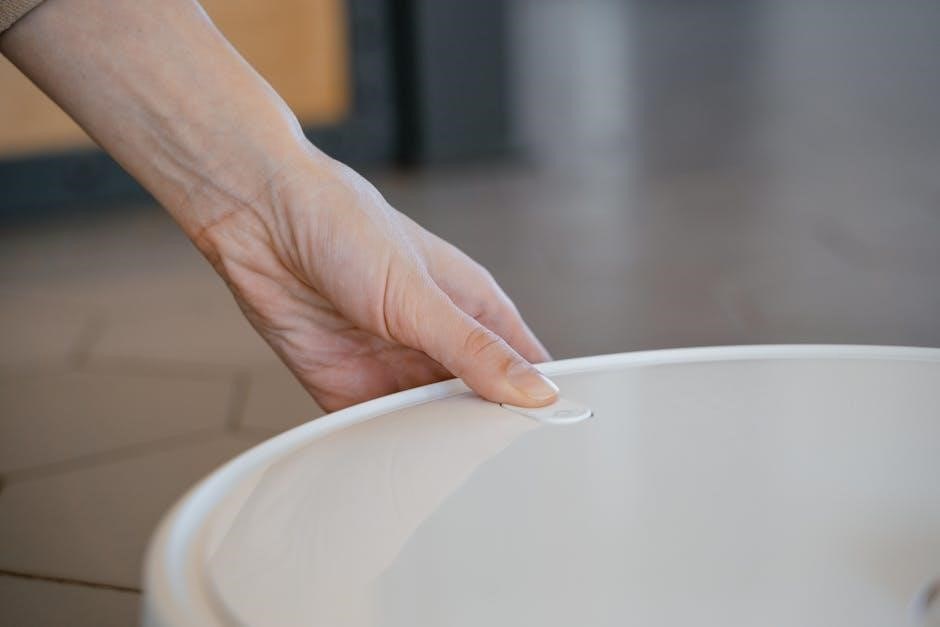
white rodgers thermostat user manual
White Rodgers Thermostat User Manual: A Comprehensive Guide
Welcome! This comprehensive guide is designed to help you navigate your White Rodgers thermostat. We’ll cover everything from finding your model number and accessing manuals to understanding basic operation and troubleshooting common issues. Let’s get started on maximizing your thermostat’s potential!
White Rodgers thermostats are known for their reliability and user-friendly design, offering a range of options from basic non-programmable models to advanced digital thermostats. Understanding the features and functionalities of your White Rodgers thermostat is crucial for maintaining a comfortable and energy-efficient home environment.
These thermostats use solid-state microcomputer technology to provide precise temperature control, ensuring consistent heating and cooling performance. Whether you’re dealing with a heat-only system, a cool-only system, or a more complex setup, White Rodgers thermostats offer solutions tailored to various needs. Many models are factory-configured for heat/cool, fossil fuel (gas, oil, etc.), forced air systems, simplifying the initial setup process.
This section will introduce you to the world of White Rodgers thermostats, highlighting their key features, benefits, and the importance of consulting your user manual for specific instructions. By familiarizing yourself with your thermostat, you can optimize its performance and ensure it meets your comfort and energy-saving goals.
Finding Your White Rodgers Thermostat Model Number
Locating your White Rodgers thermostat model number is the first step in accessing the correct user manual and support resources. This number is essential for identifying specific features, programming instructions, and troubleshooting tips relevant to your device. Typically, the model number can be found on the thermostat itself, often on the back or side.
Look for a sticker or label that displays a combination of numbers and letters. It might be near the battery compartment or behind the thermostat faceplate, which may require gently detaching it from the base. If you have the original packaging, the model number is usually printed on the box or included documentation.
Once you’ve found the model number, write it down for future reference. This will be invaluable when searching for manuals online, contacting customer support, or ordering replacement parts. Accurate identification ensures you receive the correct information and guidance for your specific White Rodgers thermostat model, maximizing its efficiency and lifespan.
Accessing Manuals Online
Once you have your White Rodgers thermostat model number, accessing the corresponding manual online is a straightforward process. Start by visiting the official White Rodgers or Emerson website, as they are often affiliated. Look for a “Support” or “Downloads” section, where you can enter your model number into a search bar.
Many third-party websites also host thermostat manuals. However, exercise caution and ensure the source is reputable to avoid downloading incorrect or potentially harmful files. Use specific search terms like “White Rodgers thermostat manual [your model number]” in your preferred search engine to narrow down the results.
When you find a potential manual, verify that it matches your model number and looks legitimate. The manual should cover basic operations, programming, troubleshooting, and wiring diagrams if applicable. Downloading the PDF version is often the most convenient option for offline access and printing. Always prioritize official sources for the most accurate and up-to-date information regarding your White Rodgers thermostat.

Downloading PDF Manuals
Once you’ve located the correct White Rodgers thermostat manual online, downloading it in PDF format is usually the next step. PDF files are ideal because they preserve the original formatting and can be easily viewed on various devices, including computers, tablets, and smartphones. Look for a download button or link, often indicated by a downward-pointing arrow or the word “Download.”
Before clicking, ensure the link is directing you to a PDF file. The file extension should be “.pdf.” If the link leads to an unfamiliar website or prompts you to download an executable file (.exe), exercise extreme caution and avoid proceeding, as it could be a potential security risk.
After clicking the download link, your browser will typically ask you where you want to save the file. Choose a location that is easy to remember, such as your “Downloads” folder or a dedicated folder for manuals. Once the download is complete, you can open the PDF file using a PDF reader like Adobe Acrobat Reader or a built-in browser PDF viewer. Now you have the manual readily available for offline consultation whenever needed.

Understanding Your White Rodgers Thermostat
Now that you have located your manual, let’s delve into understanding your White Rodgers thermostat. This section will cover basic operations, programming, setting time/day, and creating effective heating and cooling schedules for optimal comfort and energy savings.
Basic Operation of Non-Programmable Thermostats
Non-programmable thermostats offer simple, straightforward temperature control. These models typically feature a dial or slider to set your desired temperature. To operate, simply move the dial or slider to the desired heating or cooling setting. The thermostat will then activate your HVAC system to reach and maintain that temperature.
Unlike programmable thermostats, non-programmable models don’t allow you to set different temperatures for different times of the day. You manually adjust the temperature whenever you want to change it. This makes them ideal for individuals or households with consistent schedules or those who prefer a simpler approach to temperature management.
To adjust the temperature, look for the temperature scale on the thermostat. Move the dial or slider to the left for cooler temperatures and to the right for warmer temperatures. The thermostat will cycle your system on and off to maintain the set point. Some models might have a simple on/off switch or a system switch to select heat, cool, or off modes.
Remember to allow some time for the system to respond to your adjustments. Observe the room temperature to ensure the thermostat is functioning correctly and maintaining your desired level of comfort.
Programming Your White Rodgers Thermostat
Programming your White Rodgers thermostat allows you to customize your home’s temperature based on your daily schedule. This not only enhances comfort but can also lead to significant energy savings. Most programmable models offer various programming options, such as 5-1-1 (weekdays, Saturday, Sunday) or 7-day programming, providing flexibility to match your lifestyle.
To begin programming, consult your thermostat’s user manual for specific instructions, as button layouts and menu options can vary. Typically, you’ll need to enter the programming mode by pressing a “Program” or “Set” button. From there, you can set different temperatures for various time periods throughout the day, such as “Wake,” “Leave,” “Return,” and “Sleep.”
Carefully consider your daily routine when setting your program. Lowering the temperature while you’re away and raising it before you return can optimize energy efficiency. Similarly, reducing the temperature overnight can save energy while you sleep.
After setting your desired temperatures and time periods, be sure to save your program. Some thermostats have a “Run” or “Auto” mode that activates the programmed schedule. Regularly review your program to ensure it still aligns with your needs and make adjustments as necessary to maintain optimal comfort and energy savings.
Setting the Time and Day
Setting the correct time and day on your White Rodgers thermostat is crucial for accurate scheduling and efficient operation, especially for programmable models. Without the correct time, your thermostat won’t be able to follow your programmed heating and cooling schedules, leading to discomfort and wasted energy.
To set the time and day, begin by consulting your thermostat’s user manual for specific instructions, as the process can vary depending on the model. Typically, you’ll need to press a “Menu,” “Set,” or “Clock” button to enter the time and day setting mode.
Once in the setting mode, use the up and down arrow buttons to adjust the hour, minute, and day. Be mindful of AM/PM settings if applicable. Some thermostats may have separate buttons for setting the day of the week.
After setting the correct time and day, be sure to save your changes. Some thermostats will automatically save after a few seconds, while others require pressing a “Save” or “Enter” button.
Regularly check the time and day on your thermostat, especially after power outages, as these events can reset the settings. Keeping your thermostat’s time accurate ensures it operates according to your programmed schedule, maximizing comfort and energy savings.
Creating a Heating and Cooling Schedule

Creating a heating and cooling schedule on your White Rodgers programmable thermostat allows you to optimize energy usage and maintain comfort levels throughout the day and week. A well-designed schedule ensures that your HVAC system operates only when needed, reducing energy waste and lowering utility bills.
Before creating a schedule, consider your daily routines and occupancy patterns. Identify times when you’re typically away from home or asleep, and adjust the thermostat settings accordingly. Most White Rodgers programmable thermostats offer different scheduling options, such as 7-day, 5-1-1 (weekdays, Saturday, Sunday), or 5-2 (weekdays, weekend) programming.
To create a schedule, consult your thermostat’s user manual for detailed instructions. Typically, you’ll need to enter the programming mode and set different temperature points for various time periods, such as “Wake,” “Leave,” “Return,” and “Sleep.”
When setting temperatures, consider energy-saving strategies. For example, lower the thermostat temperature by a few degrees when you’re away or asleep during heating seasons, and raise it during cooling seasons.
After creating your schedule, review it carefully to ensure it aligns with your needs and preferences. You can always adjust the schedule as needed to fine-tune your comfort and energy savings. Regularly evaluate your schedule to optimize energy efficiency.

Troubleshooting Common Issues
Encountering problems with your White Rodgers thermostat? This section addresses common issues, offering potential solutions. We’ll cover unresponsive thermostats, incorrect readings, and system malfunctions. Follow these steps to diagnose and resolve common problems effectively, or know when to call a professional.

Thermostat Not Responding
If your White Rodgers thermostat isn’t responding to your inputs, several factors could be the cause. Before assuming the worst, start with the simplest solutions. First, check the power source. Ensure the thermostat is receiving power, either through batteries or a hardwired connection. Replace batteries if they are low or depleted. For hardwired models, check the circuit breaker to ensure it hasn’t tripped.
Next, inspect the wiring connections. Loose or corroded wires can disrupt the signal flow. Carefully examine the wires connected to the thermostat and ensure they are securely fastened to the correct terminals, referencing your thermostat’s wiring diagram. If you find any corrosion, gently clean the contacts before reconnecting the wires.
Another possibility is a locked thermostat. Some models have a lock function to prevent unauthorized changes. Consult your user manual to unlock the thermostat if this feature is enabled. If none of these steps resolve the issue, the thermostat may have an internal malfunction requiring professional repair or replacement.
Incorrect Temperature Readings
An inaccurate temperature reading on your White Rodgers thermostat can lead to discomfort and energy inefficiency. Start by verifying the thermostat’s location; Direct sunlight, drafts, or proximity to heat-generating appliances can all skew readings. Relocate the thermostat if necessary to a more central, stable environment away from these influences.
Next, ensure the thermostat is properly calibrated. Some models allow for manual calibration adjustments. Consult your user manual for instructions on how to calibrate your specific thermostat model. A simple adjustment can often correct minor discrepancies.
Also, consider the possibility of a faulty sensor. Over time, the sensor within the thermostat can degrade, leading to inaccurate readings. If calibration doesn’t resolve the issue, a faulty sensor may be the culprit. In this case, professional repair or thermostat replacement is usually required.

Lastly, check for dust or debris accumulation inside the thermostat. Gently clean the interior components with a soft brush or compressed air to remove any obstructions that might interfere with the sensor’s accuracy.
System Not Turning On or Off
If your heating or cooling system isn’t responding to your White Rodgers thermostat, several factors could be at play. Begin by checking the thermostat’s power source. Ensure the batteries are fresh and properly installed, or verify that the thermostat is receiving power from the electrical system. A simple power issue is a common cause.
Next, inspect the circuit breaker that controls your HVAC system. A tripped breaker can cut power to the entire system, preventing it from turning on or off. Reset the breaker and see if the problem resolves. If the breaker trips frequently, it indicates a more serious electrical issue requiring professional attention.

Also, examine the wiring connections at both the thermostat and the HVAC unit. Loose or corroded wires can disrupt the signal flow, preventing the system from responding. Tighten any loose connections and clean corroded terminals.
Finally, consider the possibility of a faulty thermostat or HVAC system component. If the above steps don’t work, consult a qualified technician.

Installation and Wiring
Proper installation and wiring are crucial for your White Rodgers thermostat. This section covers mounting, wiring connections for various systems, and configuration settings. Always refer to the specific manual for your model and prioritize safety during installation.
Mounting the Thermostat
Before you begin, ensure the power to your HVAC system is turned off at the breaker. This is a critical safety precaution. Select a location for your White Rodgers thermostat on an interior wall, away from direct sunlight, drafts, and heat sources like lamps or appliances. The ideal height is approximately five feet above the floor. Avoid mounting on exterior walls, which can be affected by outside temperatures.
Once you’ve chosen the location, use a level to ensure the thermostat is mounted straight. Mark the mounting holes using the thermostat’s backplate as a template. Drill pilot holes if necessary, especially when mounting on drywall or plaster. Secure the backplate to the wall using the screws provided, ensuring it is firmly attached. Proper mounting is essential for accurate temperature readings and reliable operation.
Double-check that the backplate is level before proceeding to the wiring connections. This will prevent any operational issues caused by improper mounting. With the backplate securely in place, you’re ready to move on to the next crucial step: wiring your White Rodgers thermostat to your HVAC system.
Wiring Connections for Different Systems

Wiring your White Rodgers thermostat correctly is crucial for proper functionality. Before connecting any wires, consult your system’s wiring diagram. Different systems, such as heat-only, cool-only, or heat/cool systems, require different wiring configurations. Typically, you’ll find terminals labeled with letters like R, W, Y, G, and C. “R” is usually for the power supply, “W” for heat, “Y” for cooling, “G” for the fan, and “C” for the common wire, if your system requires one.
For a heat-only system, you’ll likely only use the R and W terminals. For a cool-only system, you’ll use R and Y. In a heat/cool system, you’ll use R, W, and Y, and potentially G for fan control. If you have a heat pump system, the wiring might be different, often involving O/B terminals for the reversing valve.
Carefully connect the corresponding wires to the correct terminals, ensuring a secure fit. Loose connections can cause operational problems. If you’re unsure about any wiring, consult a qualified HVAC technician to avoid damaging your system or thermostat. After wiring, double-check all connections before proceeding.
Configuration Settings After Wiring
Once you’ve completed the wiring, configuring your White Rodgers thermostat is the next crucial step. Many models require specific settings to match your HVAC system type for optimal performance. These settings are usually accessed through a setup menu, often involving holding down certain buttons simultaneously.
Common configuration options include selecting the system type (heat pump, conventional), setting the heating cycle rate, and adjusting temperature swing or differential. The cycle rate determines how frequently the thermostat turns the heating or cooling system on and off. Temperature swing affects how much the temperature can deviate from the setpoint before the system activates.
Refer to your thermostat’s manual for detailed instructions on accessing and adjusting these settings. Incorrect configurations can lead to inefficient operation or system malfunctions. Some advanced models may also offer options for calibrating the temperature sensor or enabling features like adaptive intelligent recovery.
After configuring, test your system to ensure it’s functioning correctly. Monitor the temperature and system response to verify the settings are appropriate for your comfort needs and system capabilities. If you encounter any issues, revisit the configuration settings and consult your manual.